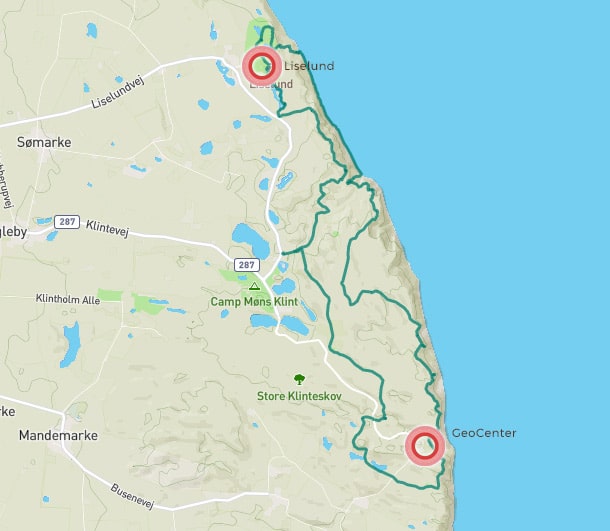Places
2 great places to start
It is obvious to start at one of the parking lots on the hike.
GeoCenter Møns Klint. Here is a large parking lot where you can start the trip. There are also good toilet facilities and an excellent café. Please note that there is a parking fee of 45 DKK.
Liselund. You can also choose to start the tour at Liselund Castle Park, which is a little gem of a romantic garden. At Liselund Ny Slot you can also spend the night, have lunch or dinner before during and after the trip around the Kingdom of the Cliff King.
GeoCenter Møns Klint
At GeoCenter Møns Klint, you can go on an interactive journey and travel 70 million years back to the Cretaceous Period and encounter the marvellous life that is the basis of Møns Klint.
The journey begins at the bottom of the sea, which at that time was filled with sharks, octopuses and sea urchins and moves through the Ice Age and when the ice masses pushed the chalk rafts together and created Møns Klint.
In the GeoCenter’s contemporary department, you can learn more about the area’s unique natural abundance. The cliff is the place in Denmark where you can find the most rare animals and plants.
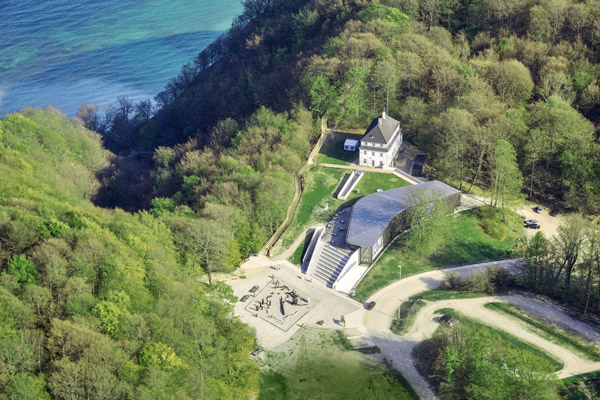
Liselund Romantic garden
Liselund Park is Denmark’s best-preserved, romantic garden. The style of soft lines, lakes, streams, waterfalls, exotic trees and small buildings was very popular in the late 18th century when Liselund was built. Therefore, the nature in the park is pure illusion. The adventurous and well-arranged landscape stands in stark contrast to the wild nature on Møns Klint. However, like the cliff, Liselund has been the target of the harsh nature: In 1905, a third of the park slipped into the sea, corresponding to approx. 40,000 m2, where great cultural values were lost.
The Liselund House and park were built by Antoine de Bosc de la Calmette as a gift of love to his wife, Lisa. Calmette was a talented painter and draftsman and designed the garden himself. The main building on two floors and with a thatched roof was completed in 1793. However, Antoine and Lisa did not get to enjoy their fairytale castle for very long. He died in 1803, and she followed two years later. Liselund was sold, but the couple’s daughter-in-law lived in the castle until her death in 1877. By then, she had long since become a living myth because she was always dressed in white and preferred to surround herself with white animals. Liselund is managed by the National Museum of Denmark. Notice the signs with the special rules for when you are in the park.
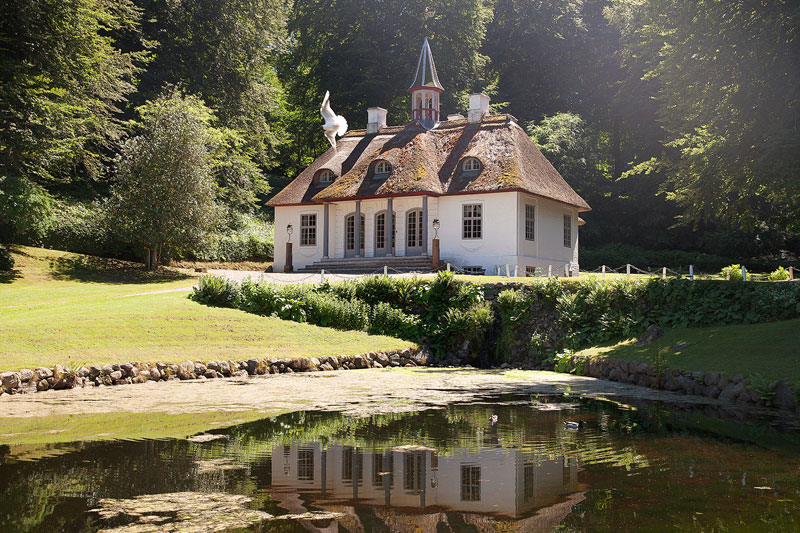
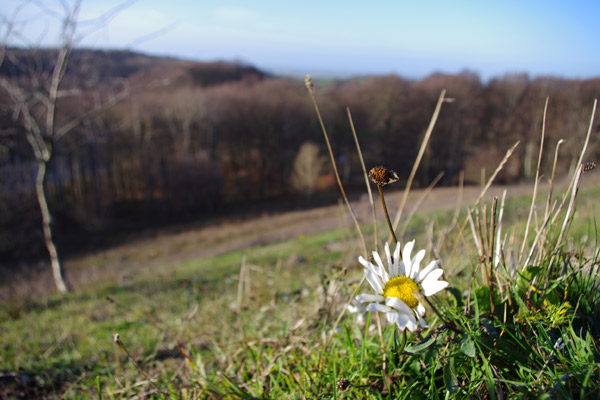
Jydelejet
Jydelejet north of Klinteskoven Forest is a soft rounded valley that cuts into the landscape behind the cliff. The area’s unique richness of rare plants and animals means that it has been known and visited by botanists and zoologists for more than 100 years. Jydelejet has been used for grazing for centuries, and the area still appears today as the pastures depicted by the Golden Age painters. Here, too, the chalk is just below the soil’s surface, and it provides, among other things, a breeding ground for orchids such as the Pyramidal Orchid, White helleborine, and Dark-red Helleborine.
In 2007-08, areas of Jydelejet were cleared of trees and shrubs to preserve the pasture’s unique nature. The project was supported by the EU’s nature conservation programme LIFE.
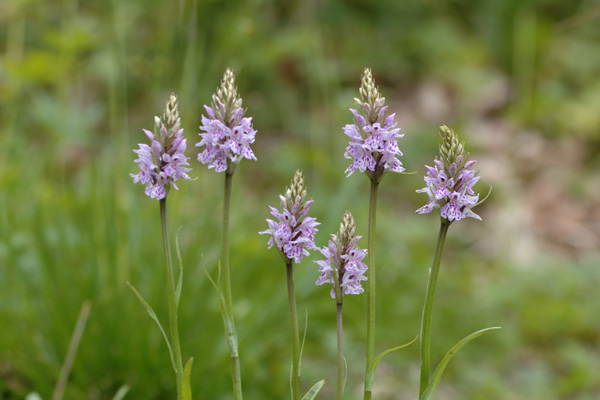
Orchids
There are about 42 wild orchid species in Denmark. 18 of them grow on Høje Møn and are found mainly on the pastures of Høvblege and Jydelejet, as well as in Klinteskoven Forest. On the map, you can see the location of the different species, while below you can read more about the individual species and their flowering. Remember that the orchids are protected and therefore must not be picked.
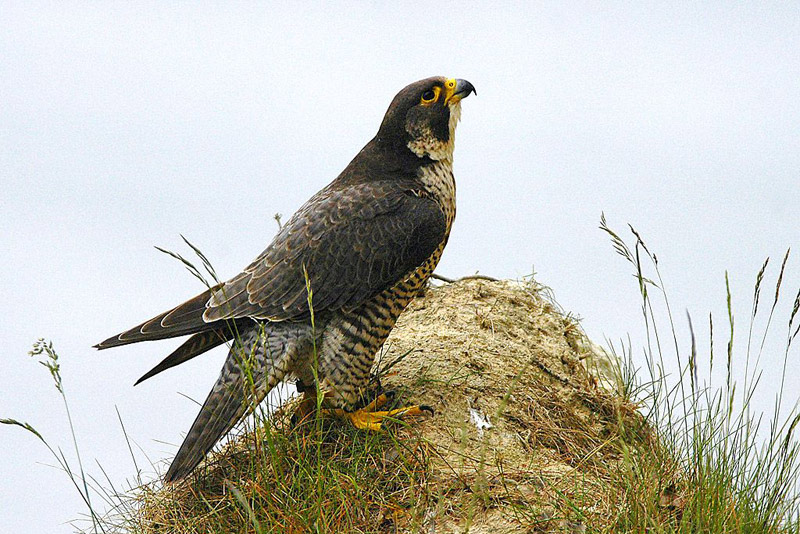
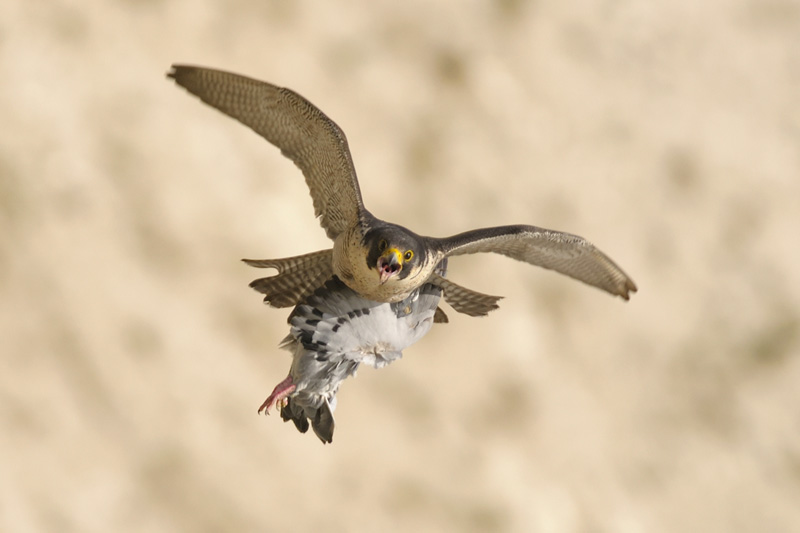
The peregrine falcon
At Møns Klint, you can be lucky to see the world’s fastest animal, the peregrine falcon. It feeds exclusively on the birds it catches in the air, especially pigeons and starlings, and chases its prey at up to 180 km per hour. However, it is its dive that makes it the world’s fastest animal. Here the peregrine falcon can reach over 300 km per hour. No other animal can do that.
For over 30 years, the peregrine falcon had disappeared from Denmark. In 1969, the last Danish falcon pair had their last live-born chicks. All subsequent eggs were barren due to environmental poison in the area, and in 1972 the pair disappeared from Denmark. The peregrine falcon became a strong symbol of the threats of environmental poison, and was instrumental in several harmful substances being banned in nature.
In 2001, a German female and a Swedish male formed a pair on Møns Klint, and in 2002 falcon chicks appeared on the cliff for the first time. Today, 2-4 pairs breed every year on Møns Klint, and a total of about 15-20 pairs in Denmark. The peregrine falcon can also be seen on Stevns Klint and Bornholm’s rocky coast. In all three places it has the opportunity to build its nest in a natural cave or on a point on the steep cliffs.
The falcon stays in several different places on Møns Klint, including here around The Queen’s Chair and Magle Water Fall. But ask at GeoCenter Møns Klint, where you can best observe the bird.
The best time to experience the falcons is from the end of May to June, when the chicks arrive on the nest shelf and take their first flights. There are also good opportunities to observe them during mating and egg laying around 1 April, and a month later when the eggs hatch.
The Queen's Chair
With its 128 metres, the Queen’s Chair (Dronningestolen) is the highest point on Møns Klint. It is also one of the steepest places, as the cliff here is almost completely vertical.
The place is named after the legend of the Cliff King (Klintekongen), who ruled over Høje Møn. Legend has it that the Queen of the Cliff King sat on the edge, which at that time had the shape of a chair. There she sat, watching for her husband when he was on a raid. The Cliff King can be equated with the chief of Nordic mythology, Odin. After the advent of Christianity in Denmark, the ancient gods were banned, and the Cliff King became a cover for the ancient deity.
The Queen’s Chair has been subjected to several major landslides. In 1914, large parts of the northern part of the point slipped into the sea, while a landslide in 1994 cost a French tourist their life. Furthermore, the area was subjected to a bombing attempt when the Germans aimed for the Queen’s Chair in May 1944 during a test of one of their secret weapons: a remote-controlled, driverless bomber.
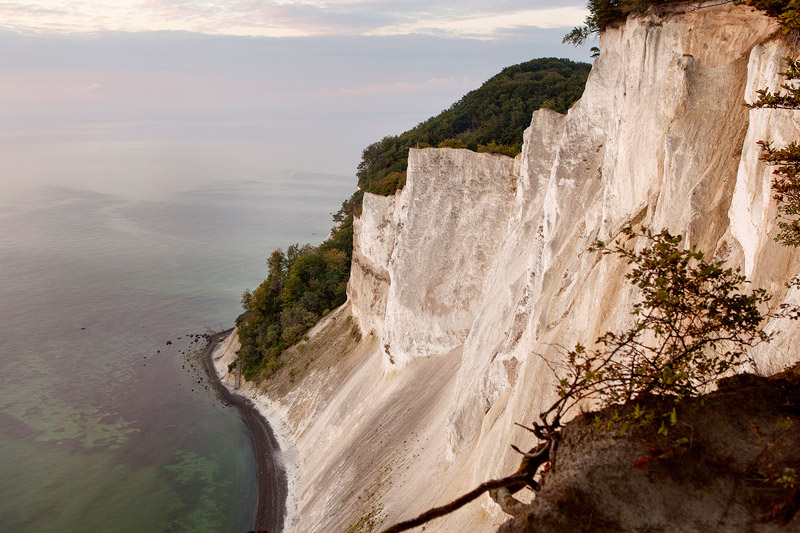
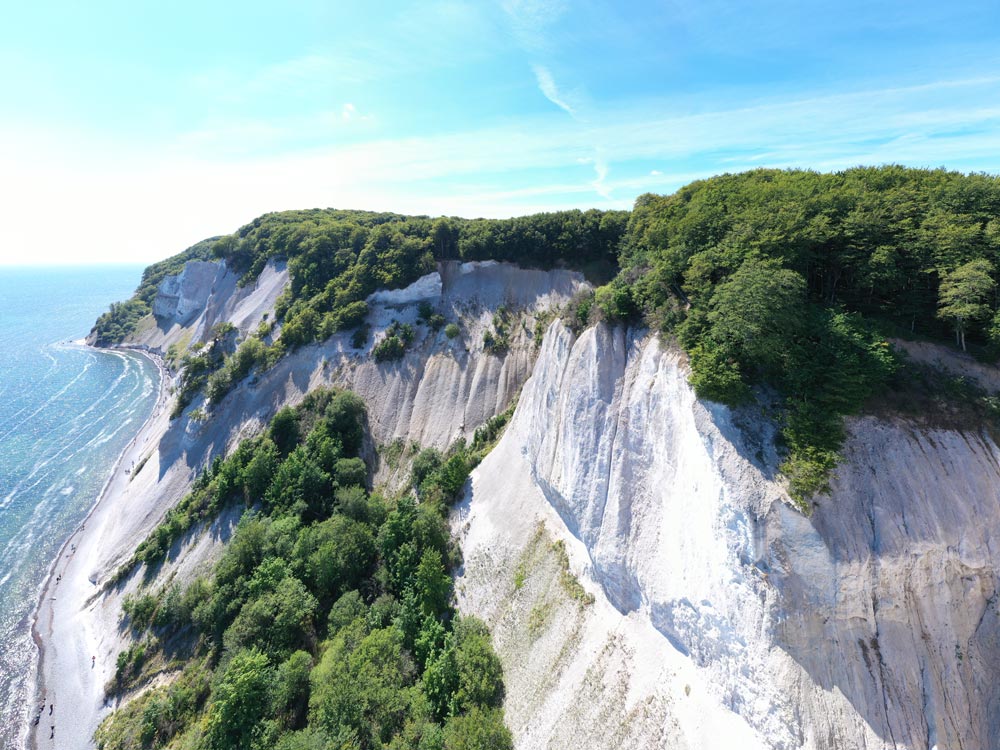
The beach and the cliff edge
The northernmost stairs of the cliff connecting Liselund Castle Park and the beach.
These stairs connect the grass pasture of Jydelejet and the beach at Møns Klint.
Klinteskoven Forest
In Klinteskoven Forest, deciduous forest alternates with conifers, and the forest offers great experiences with lakes and steep hills, soft valleys and swamps. The rugged terrain constantly opens up for new experiences, and there are plenty of opportunities to study flower flora and bird life.
In the area between Klintholm Estate and Havrelukke there are over 100 burial mounds from the Bronze Age and Iron Age. Here there are also traces of so-called ridge and trough fields - wave lines in the forest floor, which are created by the medieval farmer’s heavy wheel plough. NOTE: The part of Klinteskoven Forest that borders Klintholm Estate is private. However, you can be here from 6 in the morning to sunset, as long as you stick to roads and paths.
Also note the evergreen beech leaves and the turquoise seawater caused by calcium from the cliff.
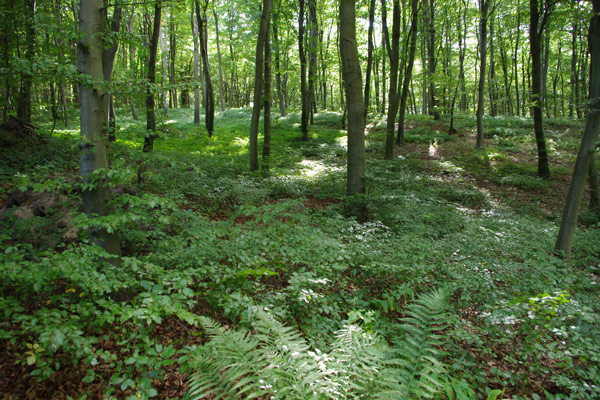
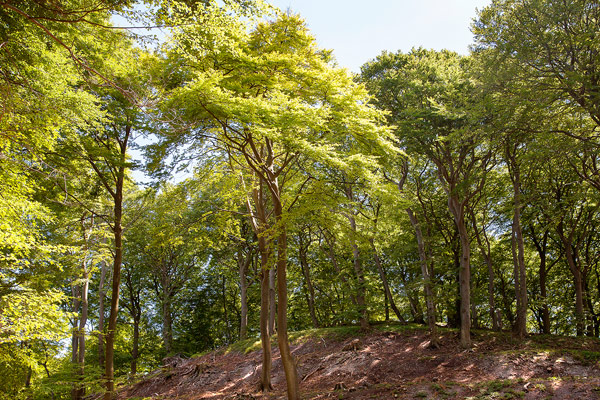
Timmesøbjerg hill
On a 113-metre high hill near Geocenter Møns Klint are the remains of a triple wooden palisade, which was first assumed to be a fortification from the Middle Ages. Later analyses have shown, however, that the construction is from the Bronze Age, and perhaps even older, from the Dagger Period, when the area’s people lived richly from the cliff’s flint depots.
Fortifications of this kind are not known from the Bronze Age, which is considered a peaceful period, and it is therefore unknown exactly how Timmesøbjerg has been used. It is likely that it has been used in several different periods of antiquity as protection against strangers who could come sailing from the water side. In the Middle Ages, the castle may have been used as a defence against Wendish pirates, but in older periods it is not known who the enemy may have been.
Within the palisades, groups of stone missiles, burnt charcoal dated to the Bronze Age, and a small bronze disc whose chemical composition indicates that it is from the Dagger Period at the end of the Neolithic Age have been found.
Aborrebjerg hill
With a height of 143 metres above sea level, Aborrebjerg is the highest point on Møn. However, the point is located inside the forest, covered with trees, and can therefore be difficult to spot. On the other hand, the point’s little sister, the 137-metre high Little Aborrebjerg, has been exposed, which is why you can experience a beautiful view over the area.
If the weather is clear, you can see all the way north to Stevns, while to the west you can see the Farø bridges and the Møn bridge.
At the top you can also see a burial mound and an overturned monumental stone from the Viking Age. Also notice how the chalk layer in the soil in several places is completely exposed in the soil surface.
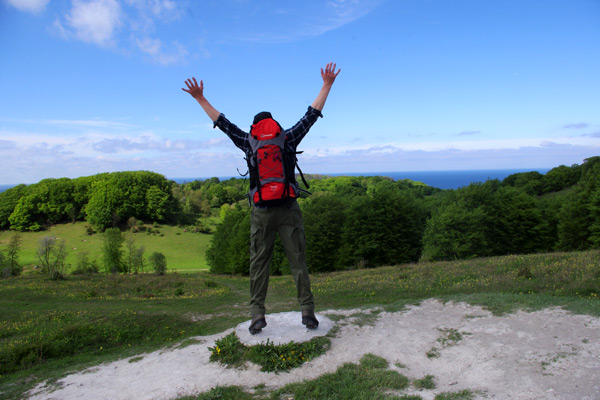
F.A.Q.
Lorem ipsum dolor sit amet.
Lorem ipsum dolor sit amet, consectetur adipiscing elit. Ut elit tellus, luctus nec ullamcorper mattis, pulvinar dapibus leo.
Lorem ipsum dolor sit amet, consectetur adipiscing elit. Ut elit tellus, luctus nec ullamcorper mattis, pulvinar dapibus leo.

